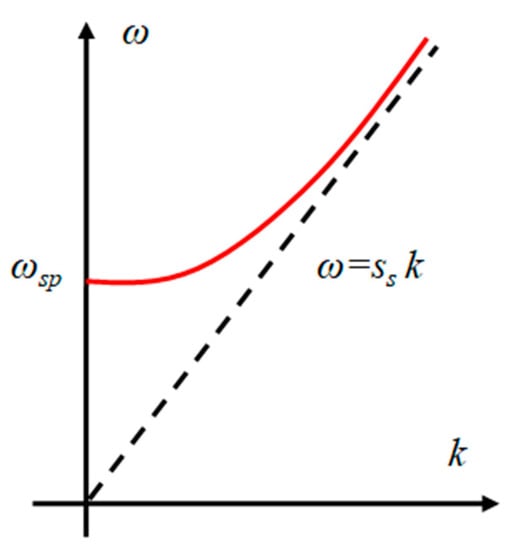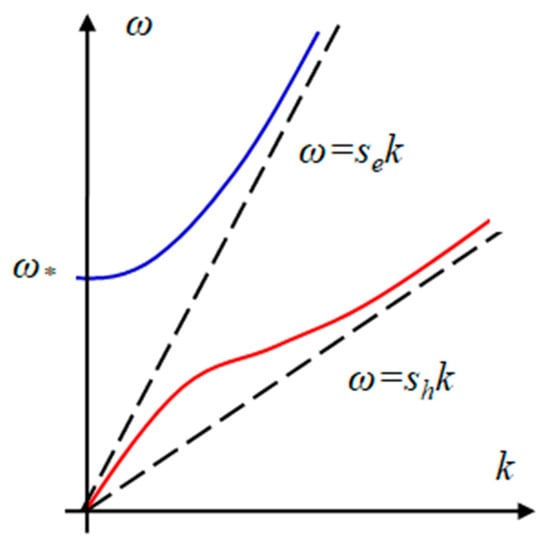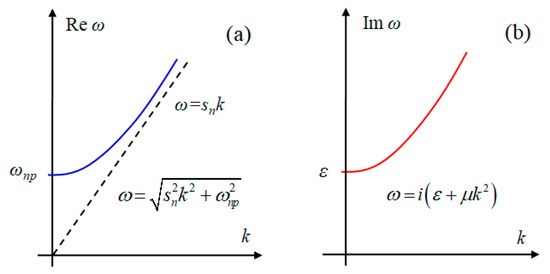Abstract
We propose a system of self-consistent equations for electron fluid in solids which describes both longitudinal vortex flows and frozen-in internal electromagnetic fields. It is shown that in the case of an ideal electron fluid, the proposed model describes the electrodynamics of the superconductor, and in the vortex-less case, it leads to modified London equations. In addition, the two-fluid model based on the proposed equations is applied to the description of an ideal electron-hole fluid in a semiconductor. The damping processes in a non-ideal electron fluid are described by modified equations, which take into account collisions with a crystal lattice and internal diffuse friction. The main peculiarities of the proposed equations are illustrated with the analysis of electron sound waves.
1. Introduction
Hydrodynamic models are widely used for the description of an electronic subsystem in solids [1]. Most research is related to the study of vortex-less flows of the electron fluid in normal metals and superconductors [2,3,4], as well as the electron-hole fluid in semiconductors [5,6,7]. However, in recent years, more attention has been paid to the effects associated with the vortex motion of the electron fluid [8,9].
For the description of vortex flows, many authors use the vector fields, including vectors of local speed and vorticity, which satisfy the symmetric Maxwell-type equations [10,11,12,13,14,15,16,17,18]. In particular, this approach is used to describe the plasma motion within the framework of a hydrodynamic two-fluid model [19,20,21,22,23]. However, in these works, an additional equation for the vortex motion is obtained by taking the “curl” operator from the Euler equation, and, therefore, the resulting equation is not independent. Recently, we developed an alternative approach based on the droplet model of fluid introduced by Helmholtz [24], and obtained a closed system of Maxwell-type equations for the vortex flows which takes into account the rotation and twisting of vortex tubes [25]. In particular, we used this approach to derive self-consistent equations for describing the electron-ion plasma [26]. In the present paper, we apply these equations to develop the hydrodynamic description of vortex flows of electron fluid in solids.
2. Hydrodynamic Model of Electron Fluid in Superconductor
2.1. System of Self-Consistent Equations
From the hydrodynamic point of view, a superconductor is an electron-ion system in which the ions are stationary, while the electronic component is a charged ideal liquid without dissipation. The system of hydrodynamic equations describing the electron fluid in a superconductor can be represented [26] in the following form:
Here, index s means the values that correspond to superconducting electrons. The parameter is the speed of sound in the superconducting electron fluid; is the local flow velocity; is a quantity proportional to the enthalpy per unit mass; is a quantity characterizing the rotation of the vortex tubes; is a quantity that characterizes the twisting of the vortex tubes; and and are the electric and magnetic fields generated by the electron fluid (see below). The parameter is defined as
where is the charge of the Cooper pair () and is the mass of the Cooper pair. The variable is
where is the enthalpy per unit mass, and is the Cooper pairs concentration ( is equilibrium concentration). The variable is
where is the angular vector of rotation of the vortex tube and is the angular velocity of the vortex tube rotation. The value characterizes the twisting of the vortex tube
where is the twisting angle of the vortex tube.
The internal electric and magnetic fields are generated only due to deviations of electron fluid parameters from equilibrium values [26]. These fields are described by the following system of equations:
Equations (1) and (6) form the self-consistent system describing the vortex electron fluid.
2.2. System of Linearized Equations
Neglecting the convective derivatives and linearizing the terms
in the field equations we obtain the following set of linearized equations:
and
For linearized equations, we obtain the following relations:
The value
represents the density of mechanical energy per unit mass. The value
is the mechanical energy flux density. The value
is the volume density of the electromagnetic energy of the internal field, and the value
is the flux density of the electromagnetic energy of the internal field.
2.3. Sound Waves in a Superconducting Condensate
Let us now consider the small fluctuations of superconducting electron fluid parameters near the equilibrium. The fluctuating contributions are denoted by values with tildes
Then, we find
and
From Equations (17) and (18), we obtain the following wave equations for the parameters of electron fluid:
and for the internal fields
Here, the parameter is the plasma frequency
Equations (19) and (20) can then be represented as a single generalized wave equation
where the generalized parameter takes any value from the set
All sound waves described by Equation (22) have the following dispersion relation
where is the frequency and is the wave number. The schematic plot of the dispersion relation Equation (24) is represented in Figure 1.

Figure 1.
The schematic plot of the dispersion curve for sound waves in the ideal electron fluid of a superconductor.
2.4. Relation to the London Equations
Let us consider the flow of a superconducting condensate without taking into account the vortex motion. Then,
and linearized Equation (8) is transformed into
Rewriting these equations using the usual terms such as the density of charge and current (taking into account the sign of the electron charge), we obtain
where
The corresponding wave equations are
Thus, Equations (29)–(31), (33), and (34) have the form of the London equations [27,28,29]. However, the propagation speed of perturbations in the electron fluid is equal to the speed of electron sound, and not the speed of light, which seems to be more adequate from a physical point of view.
3. Hydrodynamic Model of Ideal Electron-Hole Fluid in Semiconductor
Electron-hole plasma in semiconductors is also often represented as a liquid consisting of charged particles of the opposite sign. To describe sound waves, let us consider the small fluctuations of electron-hole fluid near the equilibrium state
Here, index (e is taken for electrons and h is taken for holes). Then, the linearized equations in terms of and are written as
and
From Equations (36) and (37), we obtain the following wave equations for the fluctuations of electron and hole concentrations:
Here, is the hole plasma frequency and is the electron plasma frequency:
Equation (38) can be separated as:
The same equations we obtain for the rest variables describe the electron-hole fluid. The generalized wave equation is written as
where the generalized parameter takes any values from the set
All sound waves described by Equation (43) have the following dispersion relation
The schematic plots illustrating this dispersion relation are represented in Figure 2. If , then one has two roots of Equation (45):

Figure 2.
The schematic plots of dispersion curves for sound waves in the electron-hole fluid.
If , we have two asymptotes
and
We assume that and .
The upper curve corresponds to the electron sound, while the lower curve corresponds to the hole sound. The group velocity of hole sound in the long wave limit () is
which is between .
4. Hydrodynamic Model of Electron Fluid in Normal Metal
In a normal metal, electrons collide with crystal lattice defects and phonons, which are accompanied by energy dissipation processes. Such a damping of electron fluid disturbances can be described by the following replacement of operators in all equations:
where is the average frequency of collisions. On the other hand, in the case of dense electron fluid, it is also necessary to take into account the diffusion damping of disturbances. Both these damping processes can be described by the following replacement of operators:
where is the coefficient of viscosity. Then, the linearized equations describing the motion of the electron fluid are written as follows:
and
From Equations (52) and (53), we obtain the following relations for energy and momentum:
and
To describe sound waves, let us consider the small fluctuations of electron fluid parameters in the normal metal near the equilibrium state
Then, the linearized equations for sound waves in electron fluid are
and the fields satisfy the equations
From Equations (57) and (58), we obtain the following generalized wave equation:
where the generalized parameter takes any values from the set
The dispersion relation for Equation (59) is
This equation has two roots
The real part of Equation (62) is represented in Figure 3a. If , it has the asymptote

Figure 3.
The schematic plots of dispersion curves for electron sound waves in normal metal. (a) The dependence of the frequency on the wave number. (b) The dependence of the decrement on the wave number.
The imaginary part of Equation (62) is represented in Figure 3b. It corresponds to the damped sound waves with decrement .
5. Conclusions
We have thus proposed a self-consistent hydrodynamic model for non-radiative electron fluid in solids consisting of the equations for the vortex flow of electron fluid and the equations for the frozen-in electromagnetic field. Frozen fields satisfy modified Maxwell’s equations, which show that they are caused by currents and charge density fluctuations and move along with the electron fluid. To take into account the processes of electromagnetic wave radiation, this model must be supplemented with equations for electromagnetic fields in a vacuum and energy balance equations. Electromagnetic fields from external sources can also be taken into account additively in the system of equations describing the electron fluid [30].
The proposed approach enables the description of superconducting condensate in the superconductor as the ideal electron fluid without dissipation. In the case of vortex-less flow, it leads us to equations very close to the London equations, but the speed of the propagation of small fluctuations is equal to the speed of electron sound, not the speed of light. This seems to be more appropriate from a physical point of view. The damping processes in normal metals can be described by modifying the operator parts of the equations with additional terms that denote the electron collision frequency and internal diffusion friction in electron fluid. Moreover, we have shown that the electron-hole plasma in a semiconductor can be described by similar equations within the two-fluid model.
The advantages of self-consistent equations have been illustrated by the derivation and analysis of the wave equations for electron sound waves in solids.
Funding
This research received no external funding.
Institutional Review Board Statement
Not applicable.
Informed Consent Statement
Not applicable.
Data Availability Statement
The data that support the findings of this study are available within the article.
Acknowledgments
The author is grateful to Galina Mironova for moral support and to Sergey Mironov for helpful discussions and criticism. Special thanks to MDPI for supporting the publication and personally to the Managing Editor for kind assistance and cooperation.
Conflicts of Interest
The author declares no conflict of interest.
References
- Gurzhi, R.N. Hydrodynamic effects in solids at low temperature. Sov. Phys. Uspekhi 1968, 11, 255–270. [Google Scholar] [CrossRef]
- de Jong, M.J.M.; Molenkamp, L.W. Hydrodynamic electron flow in high-mobility wires. Phys. Rev. B 1995, 51, 13389. [Google Scholar] [CrossRef]
- Greiter, M.; Wilczek, F.; Witten, E. Hydrodynamic relations in superconductivity. Mod. Phys. Lett. B 1989, 3, 903–918. [Google Scholar] [CrossRef]
- Liu, M. Superconducting hydrodynamics and Higgs analogy. J. Low Temp. Phys. 2002, 126, 911–922. [Google Scholar] [CrossRef]
- Akbari-Moghanjoughi, M.; Eliasson, B. Hydrodynamic theory of partially degenerate electron–hole fluids in semiconductors. Phys. Scr. 2016, 91, 105601. [Google Scholar] [CrossRef]
- Maack, J.R.; Mortensen, N.A.; Wubs, M. Two-fluid hydrodynamic model for semiconductors. Phys. Rev. B 2018, 97, 115415. [Google Scholar] [CrossRef]
- Svintsov, D.; Vyurkov, V.; Yurchenko, S.; Otsuji, T.; Ryzhii, V. Hydrodynamic model for electron-hole plasma in grapheme. J. Appl. Phys. 2012, 111, 083715. [Google Scholar] [CrossRef]
- Pellegrino, F.M.D.; Torre, I.; Geim, A.K.; Polini, M. Electron hydrodynamics dilemma: Whirlpools or no whirlpools. Phys. Rev. B 2016, 94, 155414. [Google Scholar] [CrossRef]
- Aharon-Steinberg, A.; Völkl, T.; Kaplan, A.; Pariari, A.K.; Roy, I.; Holder, T.; Wolf, Y.; Meltzer, A.Y.; Myasoedov, Y.; Huber, M.E.; et al. Direct observation of vortices in an electron fluid. Nature 2022, 607, 74–80. [Google Scholar] [CrossRef]
- Logan, J.G. Hydrodynamic analog of the classical field equations. Phys. Fluids 1962, 5, 868–869. [Google Scholar] [CrossRef]
- Marmanis, H. Analogy between the Navier-Stokes equations and Maxwell’s equations: Application to turbulence. Phys. Fluids 1998, 10, 1428–1437. [Google Scholar] [CrossRef]
- Kambe, T. A new formulation of equation of compressible fluids by analogy with Maxwell’s equations. Fluid Dyn. Res. 2010, 42, 055502. [Google Scholar] [CrossRef]
- Kambe, T. On fluid Maxwell equations. In Springer Proceedings in Physics, Vol. 145. Frontiers of Fundamental Physics and Physics Education Research; Sidharth, B.G., Michelini, M., Santi., L., Eds.; Springer: Heidelberg, Germany, 2014; pp. 287–296. [Google Scholar]
- Demir, S.; Tanişli, M. Spacetime algebra for the reformulation of fluid field equations. Int. J. Geom. Methods Mod. Phys. 2017, 14, 1750075. [Google Scholar] [CrossRef]
- Thompson, R.J.; Moeller, T.M. Numerical and closed-form solutions for the Maxwell equations of incompressible flow. Phys. Fluids 2018, 30, 083606. [Google Scholar] [CrossRef]
- Mendes, C.R.; Takakura, F.I.; Abreu, E.M.C.; Neto, J.A. Compressible fluids with Maxwell-type equations, the minimal coupling with electromagnetic field and the Stefan-Boltzmann law. Ann. Phys. 2017, 380, 12–22. [Google Scholar] [CrossRef]
- Mendes, C.R.; Takakura, F.I.; Abreu, E.M.C.; Neto, J.A.; Silva, P.P.; Frossad, J.V. Helicity and vortex generation. Ann. Phys. 2018, 398, 146–158. [Google Scholar] [CrossRef]
- Tanişli, M.; Demir, S.; Sahin, N. Octonic formulations of Maxwell type fluid equations. J. Math. Phys. 2015, 56, 091701. [Google Scholar] [CrossRef]
- Demir, S.; Tanişli, M.; Kansu, M.E. Octonic Maxwell-type multifluid plasma equations. Eur. Phys. J. Plus 2021, 136, 332. [Google Scholar] [CrossRef]
- Thompson, R.J.; Moeller, T.M. A Maxwell formulation for the equations of a plasma. Phys. Plasmas 2012, 19, 010702. [Google Scholar] [CrossRef]
- Thompson, R.J.; Moeller, T.M. Classical field isomorphisms in two-fluid plasmas. Phys. Plasmas 2012, 19, 082116. [Google Scholar] [CrossRef]
- Chanyal, C.; Pathak, M. Quaternionic approach to dual Magneto-hydrodynamics of dyonic cold plasma. Adv. High Energy Phys. 2018, 13, 7843730. [Google Scholar]
- Tanişli, M.; Demir, S.; Sahin, N.; Kansu, M.E. Biquaternionic reformulation of multifluid plasma equations. Chin. J. Phys. 2017, 55, 1329. [Google Scholar]
- Helmholtz, H. Über Integrale der hydrodynamischen Gleichungen, welche den Wirbelbewegungen entsprechen. J. Für Die Reine Und Angew. Math. 1858, 55, 25–55. [Google Scholar]
- Mironov, V.L.; Mironov, S.V. Generalized sedeonic equations of hydrodynamics. Eur. Phys. J. Plus 2020, 135, 708. [Google Scholar] [CrossRef]
- Mironov, V.L. Self-consistent hydrodynamic two-fluid model of vortex plasma. Phys. Fluids 2021, 33, 037116. [Google Scholar] [CrossRef]
- London, F.; London, H. The electromagnetic equations of supraconductor. Proc. R. Soc. Lond. A 1935, 149, 71–88. [Google Scholar]
- Mironov, V.L. Generalization of London equations with space-time sedeons. Int. J. Geom. Methods Mod. Phys. 2021, 18, 2150039. [Google Scholar] [CrossRef]
- Weng, Z.-H. Superconducting currents and charge gradients in the octonion spaces. Eur. Phys. J. Plus 2020, 135, 443. [Google Scholar] [CrossRef]
- Mironov, V.L. Quaternion equations for hydrodynamic two-fluid model of vortex plasma. Int. J. Geom. Methods Mod. Phys. 2022; in press. [Google Scholar] [CrossRef]
Publisher’s Note: MDPI stays neutral with regard to jurisdictional claims in published maps and institutional affiliations. |
© 2022 by the author. Licensee MDPI, Basel, Switzerland. This article is an open access article distributed under the terms and conditions of the Creative Commons Attribution (CC BY) license (https://creativecommons.org/licenses/by/4.0/).